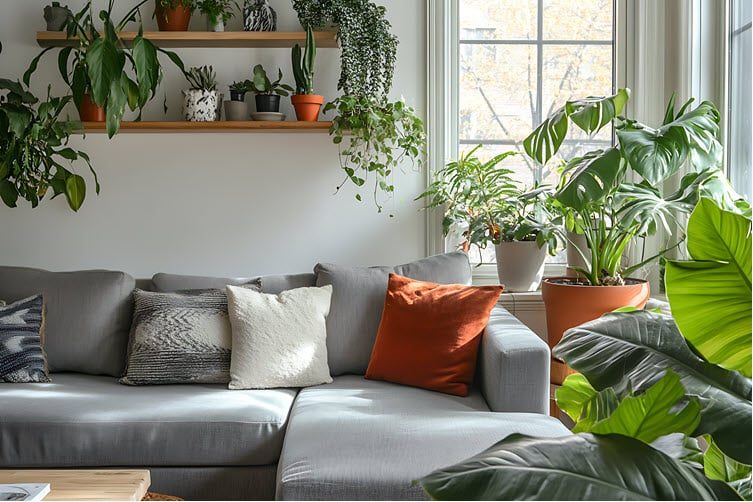Sharing is Caring!
If you are tired of dusting your home, consider discovering some of the best houseplants that can help reduce and remove dust and allergens. These houseplants can serve as natural air purifiers while also adding beauty to every room.
I love my beautiful and unique houseplants, and for many of us, they bring color, nature indoors, and clean air. Now, they can also help remove dust and allergens!
We participate in the Amazon Services LLC Associates Program, Skimlinks, and other Associate Affiliate Programs. Affiliate advertising programs like these allow us to earn fees by linking to affiliated sites at no cost to you.
As Amazon Associates, we earn from qualifying purchases. Please check our Disclosure Privacy Policy page. Thank you for supporting our website.
Can Houseplants Really Help Remove Dust?
So, is it some magical process? No, this isn’t a magical process; it’s simply a result of the dust adhering to the plant’s surface, much like it would on any other piece of furniture.
While this can help reduce the amount of dust floating in the air, it’s not a substitute for regular cleaning.
Of course, you will still need to dust your home, but perhaps not as much or as often. That works for me! If this means houseplants help remove dust and allergens, and look beautiful? It’s a win-win.
Furthermore, there is a process called phytoremediation, which utilizes a plant’s natural processes to purify indoor air.
Adding these plants to your home is a simple and attractive way to improve air quality and promote overall well-being.
Are They Effective?
To begin, the belief that plants are highly effective at cleaning indoor air often stems from a 1989 NASA study, which found that certain plants could remove volatile organic compounds (VOCs) in a small, sealed laboratory chamber.
Houseplants with broad, textured, or waxy leaves act as passive dust collectors by providing surfaces for airborne particles to settle. Moreover, this is not an active purification process but works similarly to how dust accumulates on furniture.
While plants can help reduce dust, regular cleaning is still necessary. Of course, you’ll need to keep your plants clean and healthy along the way. That’s why it’s a good idea to wipe its leaves with a damp cloth to remove dust.
I do this weekly, and my plants help me keep dust at bay in my home.
Furthermore, I also get to enjoy their beauty in every room. I also talk to my houseplants almost every day. This helps them stay healthy, and I know it works firsthand.
Below, you’ll discover which of these best houseplants can help you remove dust and keep your space healthier.
Here are 10 houseplants that are particularly effective at collecting dust:
1 – Rubber Plant (Ficus elastica)
Known for its large, glossy, and leathery leaves, the rubber plant is an excellent choice for trapping dust. Its expansive leaf surface provides ample area for particles to settle.
I love my Rubber Plant for so many reasons.
The leaves are large and perfectly green. I also love how quickly they grow. They also have a symbolic connection to wealth and good luck in feng shui, which enhances their appeal as a durable and beautiful addition to any space.
Furthermore, Rubber Plants are low-maintenance, which is a plus for me. I prefer houseplants that require minimal care, as I lead a busy lifestyle.
Next, it’s visually beautiful with its large, waxy leaves.
You can place it on the floor or on top of a piece of furniture. Either way, Rubber Plants act as a powerful air purifier, removing toxins like formaldehyde from your indoor environment.
2 – Peace Lily (Spathiphyllum)
This plant features broad, dark green leaves that are not only beautiful but also very good at attracting dust and other airborne particles. It also helps to absorb excess moisture, which can reduce dust and mold growth.
I’ve always had a Peace Lily in my home for years. I love how they look and the flowers they bloom.
Furthermore, they have elegant, glossy dark green leaves that provide a lush, tropical look. I also love their striking, long-lasting white “flowers” (which are actually modified leaves called spathes) that bloom for months.
They are also known for being very forgiving and low-maintenance, even communicating their needs dramatically by drooping when they are thirsty. Amazingly, they quickly perked back up after a drink. This lily makes some of the best houseplants you can own for many reasons.
Beyond their aesthetics, peace lilies are excellent natural air purifiers, helping to remove dust and common toxins from indoor air.
Ideally, this makes them a great choice for creating a healthier and more serene living environment.
3 – Snake Plant (Dracaena Trifasciata)
The upright, stiff, and sword-like leaves of the snake plant have a significant surface area to collect and help remove dust from our homes. Its low-maintenance nature makes it a popular choice for many homes.
Snake plants are an excellent choice for a houseplant due to their striking, upright appearance and incredibly low-maintenance nature. They are well-known for their ability to purify indoor air by removing toxins like formaldehyde and benzene.
Ideally, what sets them apart from other houseplants is that they continue to produce oxygen at night. For this reason, you can also use them in your bedroom.
Their resilience to neglect, ability to tolerate low light conditions, and minimal watering needs make them perfect for beginners or anyone with a busy lifestyle.
Actually, Snake Plants were among the first houseplants I bought and loved for many years.
Again, this is why plants with large, broad leaves, such as a Peace Lily or Snake Plant, are beneficial for removing dust from our homes. Their wide surface area provides a place for dust to land.
However, this also means you need to regularly wipe down the leaves with a damp cloth to remove dust; otherwise, you can redistribute it back into the air. In this way, the plants act more like a static duster than a self-cleaning air purifier.
4 – Pothos Plant (Epipremnum Aureum)
The Pothos Plant can naturally remove dust from your home while also beautifying it. Also known as Devil’s Ivy, the heart-shaped, waxy leaves of the pothos vine are highly effective at trapping dust.
Its fast-growing nature means it quickly provides a large surface area for collection.
I love Pothos Plants, and you’ll often hear them called “Devil’s Ivy,” These plants are beautiful and highly popular and make some of the best houseplants you can own.
Furthermore, they offer striking foliage and graceful, trailing vines. Their beauty comes from their heart-shaped leaves, which can be solid green or beautifully variegated with splashes of yellow, white, or silver, depending on the variety.
Additionally, they offer a versatile vining nature, allowing you to hang them from baskets, drape them over anything, and train them to climb up moss poles. Doing so adds a lush, tropical feel to any room.
Pothos are also celebrated for their resilience and ability to thrive in a wide range of conditions, making them a perfect, low-maintenance choice for both beginner and experienced plant owners.
In terms of dust control, Pothos plants, like many other large-leaved houseplants, act as natural dust collectors. Airborne dust particles settle on their broad, waxy leaves, effectively removing them from the air.
If you want to own one of the best houseplants, be sure to check out Pothos!
5 – Spider Plant (Chlorophytum Comosum)
The long, arching leaves of the spider plant are great for passively collecting dust. Its easy-to-care-for nature and ability to grow in a hanging basket make it a versatile choice.
I love Spider Plants and have owned them throughout my life. They make excellent houseplants, and I love their aesthetic appeal. They also offer practical benefits.
You’ll see them almost everywhere you go, from businesses to doctors’ offices to private homes.
First, they often have variegated ribbon-like leaves and produce shades of green and white. This colorful cascading effect makes them perfect in so many ways. For example, you can hang them in baskets or place them on shelves.
Another charming feature is that they also produce small, baby plants on long stems called “spiderettes,” which you can easily propagate. Furthermore, this will allow you to create new plants and expand your collection.
You can also share them with your friends and loved ones.
In terms of dust control, spider plants, like other large-leaved plants, serve as natural dust collectors. Their numerous, broad leaves provide a significant surface area for airborne dust particles to land and settle on, effectively removing them from circulation in your home.
6 – Boston Fern (Nephrolepis Exaltata)
Typically, I love any fern, but my favorite is the Boston Fern. The dense, feathery fronds of the Boston fern are adept at catching airborne dust. Additionally, ferns are known to increase indoor humidity, which can cause dust particles to become heavier and settle out of the air.
Additionally, they offer lush, green, and elegant foliage.
Plus, they are ideal for hanging baskets, patios, or indoor spaces, bringing a fresh, tropical feel to any environment.
This live fern naturally filters indoor air, removing toxins like toluene and xylene while increasing humidity for a fresher home. Ideal for homes, offices, and patios, it enhances well-being and promotes a calming atmosphere with its lush, vibrant greenery.
Boston Ferns thrive in indirect sunlight and high humidity with minimal effort. Mist them regularly and keep the soil slightly moist for long-lasting, lush foliage. Perfect for both beginners and experienced plant lovers.
7 – Monstera Plant (Monstera Deliciosa) – Remove Dust with Style
The large, perforated leaves of the Monstera plant are not only a striking design feature but also an effective surface for collecting dust.
The unique shape and size of the leaves create many nooks and crannies for particles to cling to.
The beautiful Monstrea offers a signature Split-Leaf Foliage, and its glossy green leaves are simply stunning. The leaves have natural splits and holes, creating a striking tropical look for any indoor space.
More so, they thrive in bright, indirect light and grow best near windows with filtered sunlight. They can tolerate moderate indoor lighting conditions. You will find them easy to maintain as well, and require watering when the top inch of soil feels dry.
This Monstera naturally filters indoor air.
Excitingly, they offer air purifying benefits and naturally filter indoor air. Furthermore, this helps remove dust and allergens from the air.
8 – ZZ Plant (Zamioculcas Zamiifolia)
The smooth, waxy leaves of the stunning ZZ plant are excellent dust magnets. This plant is also known for being incredibly hardy and tolerant of neglect, making it a great option for beginners. I have one in my shopping cart as I write this because I love the beauty of this plant and its ability to help purify the air.
More so, it is an excellent houseplant for adding a touch of modern beauty to your home.
I adore its key aesthetic features and its bold form. It features thick, upright, green, gorgeous stems with glossy, dark leaves.
Furthermore, the ZZ plant is so stunning that it looks artificial! This plant is perfect and complements a wide range of interior styles from minimalist to tropical.
Additionally, the ZZ plant is incredibly versatile, thriving even in low-light conditions where other plants might struggle. It’s the perfect choice for beautifying a dark corner, hallway, or office space, making greenery accessible in areas of your home that may not receive ample natural light.
Like other houseplants with broad leaves, the ZZ plant can help with dust control in your home.
It doesn’t actively filter dust from the air like a machine, but its wide, smooth leaf surfaces serve as natural collectors for airborne dust particles.
If you love tips on how to keep dust at bay, you’ll love this one. As dust settles on the leaves, it effectively removes dust from circulation. You can’t go wrong with this stunning ZZ plant in your space. I ordered one on Amazon, and I’m eager to receive mine!
9 – Areca Palm (Dypsis Lutescens)
With its lush, multi-stemmed fronds, the Areca Palm plant provides a large and complex surface area to trap dust.
A taller plant can have a significant effect on a room’s dust levels.
The Areca Palm is a fantastic choice for both enhancing the beauty of your home and purifying the air. Ideally, this plant features elegant, feathery fronds and a graceful, arching shape that give it a classic tropical look, instantly transforming a room into a serene, vacation-like retreat.
As a larger plant, it can serve as a stunning focal point in a living room, entryway, or any space with sufficient light. This palm’s lush, vibrant green foliage adds a soft, natural element to interior design, making a space feel more alive and welcoming.
When it comes to helping us remove dust from the air, the Areca Palm’s numerous fronds and leaflets provide a large surface area for dust to settle on. Airborne particles land on these leaves, which effectively removes them from the air you breathe.
This Areca Palm is a great choice to help remove dust and enhance the beauty of our homes.
10 – Philodendron (Philodendron Spp.)
Many varieties of Philodendron have broad, heart-shaped leaves that are perfect for catching dust. Their vining growth habit means they can be used in hanging baskets, allowing their leaves to interact with more of the air in a room.
The Philodendron is an excellent choice for a houseplant due to its aesthetic appeal and ability to help control dust. There are hundreds of Philodendron species, but they are generally known for their glossy, heart-shaped leaves and vining or upright growth habits.
I love caring for the Philodendron and have owned many over the course of my life. They always add a touch of beauty to any home decor, and you can use them in any room in your home.
They are also celebrated for being exceptionally low-maintenance and forgiving, as they tolerate a wide range of lighting conditions and are resilient to occasional neglect.
Of course, this makes them perfect for both beginners and experienced plant owners.
Like many houseplants with broad leaves, the Philodendron is a passive dust collector. Dust and other airborne particles land and settle on its leaves, which effectively removes them from circulation in the air.
Ideally, you can use them in hanging baskets to create a beautiful cascade of green, or train them to climb a moss pole for a more vertical, jungle-like look.
Don’t Forget To Pin Your Inspiration!
We participate in the Amazon Services LLC Associates Program, Skimlinks, and other Associate Affiliate Programs. Affiliate advertising programs like these allow us to earn fees by linking to affiliated sites at no cost to you. As Amazon Associates, we earn from qualifying purchases.
Please check our Disclosure Privacy Policy page. Thank you for supporting our website.
Sharing is Caring!
Disclaimer: This story is auto-aggregated by a computer program and has not been created or edited by jennertrends.
Publisher: Source link













